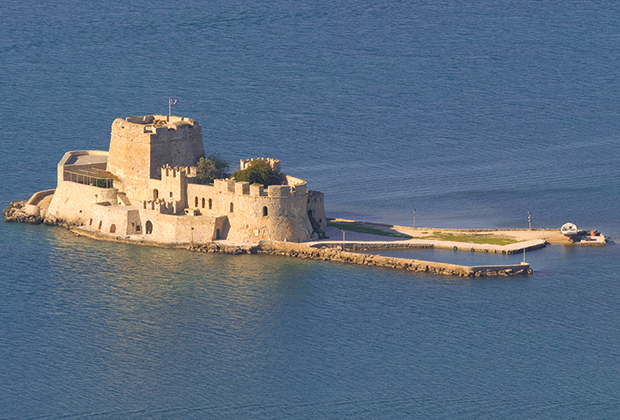My Favorite Greek Road Trips: Athens to Nauplion

Alexander Billinis
When we lived in Athens several years ago, just before the cracks in the Greek pavement were beginning to appear, one of our favorite things to do on the weekends was to get out of the city. Luckily the means to exit were readily available; Athens’ Germanic Ring Road, the Attiki Odos, was no more than a kilometer from our Nea Philothei apartment. I quickly developed a series of favorite day or multi-day trips out of Athens.
One such trip is to the city of Nauplion, on the eastern shore of the Peloponnesus, a few hours away. Barring an accident, and driving no faster than the average Athenian, I could clear Athens and the ugly Eleusina industrial suburbs in 25 minutes, after which the crisp cleanliness of the Attiki Odos, privately run, gives way to the Ethniki Odos, shabbier but still a modern six lane job. Below us, the Salamis Channel narrows considerably to the mainland, and here, twenty-five centuries ago, the Athenians trapped and utterly destroyed the Persian fleet.

Bourtzi, the iconic Venetian island castle in the harbor
After over a dozen tunnels slicing efficiently through the coastal mountains and the parched plains of Megara, we arrive at Corinth, in just about one hour. Today the Corinth Canal is easily missed on the new highways, which cross it in a blink of an eye, but if, like me, you have a primal need for coffee, it is an excuse to pull off just before the bridge. No great cafés line this route, but take one to go and stretch your legs over the canal bridge, particularly if you have kids, because this nineteenth century feat of engineering is worth the vertigo-inducing view. Just south of the canal is another piece of engineering, the Hexamilion (Six Mile) Wall, first built to keep the Persians out, repaired in early Byzantine times to keep the Slavs out of the Peloponnesus, and in the twilight of Byzantium, to keep out the Turks. Not much is left today, but it is a reminder that walls alone seldom work their purpose.
The Peloponnesus, known in Byzantine times as the Morea, presents a number of options, but let’s stay focused and go to Nauplion, which requires rejoining the Ethniki Odos towards Tripolis for a few more kilometers, we pass by the huge outcrop of Acrocorinth, a Classical-Roman-Byzantine-Ottoman castle, and shortly thereafter we turn off for Nauplion, near the wine roads of Nemea. There is also a sign for a small village called Dervenakia, where, in 1821, Ottoman Turkish troops were trapped in the narrow pass and dealt a punishing defeat by the Greek revolutionaries. Don’t expect signs and a battlefield park, like at American Civil War battlefields. After a search, I found a small statue and nothing else.
Due east the winding road to Nauplion beckons, the roadside flanked by stalls selling honey and exquisite Nemean wine. Do stop for a purchase and a taste, although I have gotten carried away and luckily my wife “designated drove.” Our direction is downward and southeasterly, out of the mountains, and we arrive at the plain of Argos, densely populated with orange trees and 4000 years of civilization.
Again we stop, a stall full of oranges at five euros for ten kilos has our name on it. After all, five euros will not get you a glass of fresh orange juice in the hip cafés of Athens. The whole plain is green and orange, full of groves, save for patches of village, and, of course, Mycenae on its hill. Our destination in mind, we do not turn to the stark and haunting ruins of Mycenae, nor do we stop at Tyrinitha, another Mycenaean site, this time right off the road to Nauplion.
Arriving, in Nauplion, we skirt the military base and Greece-typical concrete bunker apartments, toward the promontory that is old Nauplion. Though including the remnants of Mycenaean, Classical, Roman, Byzantine, Crusader and Ottoman cultures, Nauplion is a child of Venice. Venice briefly wrested the Peloponnesus from the Turks from 1699 to 1715, and then made Nauplion the capital of the Peloponnesus, endowing it with lovely buildings, the crowning military fortress of Palamidi, and an Italianate sense of grace and proportion rare in Greece cities except in the Ionian Islands.
Feeling the need for coffee and, for wife and kids’ sake, some sweets, we go to my favorite café, Napoli di Romania, owned by a koumbaro of mine who once lived in my Salt Lake City hometown. Immaculate with white marble interior, uniformed waiters, and coffee every bit the peer of Trieste, Venice, or Vienna, the café, whose name recalls the Venetians’ name for Nauplion, is perfect for indoor or outdoor discourse and people watching, winter and summer. After this, you are ready for a stroll, which should first take you by the seaside, just a few dozen meters from the café.
After taking in the seascape, perhaps, arranging for a trip to the Bourtzi, the iconic Venetian island castle in the harbor, go into the old town itself, where a Venetian grid pattern and Italianate structures prevail in the flat ground, while Balkan style architecture predominates on higher ground. Around Syntagma Square there are scores of tiny boutiques and taverns, perfect for either a quiet romantic dinner or other spots for lively enjoyment by the whole family. The Greek experience here is unspoiled; the town remains much the same as it was when it served, for a few years, as Greece’s first capital.
Often I have found the most intimate, contemplative, and romantic tourist venues are the smaller cities, like Nauplion, that sometime in their history switched from the fast lane to a slower one, but kept their monuments and elegance from their time in the spotlight. Nauplion is such a place. From its towering fortress, Palamidi, where each conqueror like a hermit crab inhabited the shell of its predecessor, the view is breathtaking, the whole plain of Argos, the citrus farm of Europe, glitters orange and green, and the view of the down, 999 steps below, is awe-inspiring.
Easily one of the most pleasant towns in Greece, Nauplion also provides a warning as to the Greeks’ penchant for self-destruction. In the more winding roads of the old town, there is a small church, typical of the kind constructed during the Ottoman era, small, with no dome, so as not to offend the conqueror. There is a plaque, and a preserved bullet hole, to mark the spot where the first governor of Greece, the Corfu aristocrat Count Kapodistrias, met an untimely end from a political enemy. This man, who had served with distinction as Russia’s foreign minister, returned from a comfortable Diaspora life to serve his country, and to what end? It almost seemed like a cautionary tale.
I digress, but notwithstanding this depressing reminder of Greece’s past turbulence which resonates to the present day, Nauplion is one of those trips where getting there is more than half the fun. Greece is so profound as to be distracting, and luckily, with its near-complete superhighway network, even the most remote nooks and crannies of this beautiful country are within easy reach.











0 comments